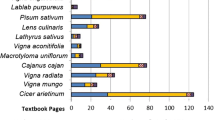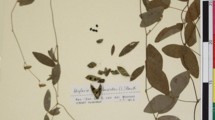Abstract
All modern domesticated sunflowers can be traced to a single center of domestication in the interior mid-latitudes of eastern North America. The sunflower achenes and kernels recovered from six eastern North American sites predating 3000 b.p. that document the early history of this important crop plant are reanalyzed, and two major difficulties in the interpretation of archaeological sunflower specimens are addressed. First, achenes and kernels obtained from a modern wild sunflower population included in a prior genetic study because of its minimal likelihood for crop-wild gene flow, and its close genetic relationship to domesticated sunflowers, provide a new and more tightly drawn basis of comparison for distinguishing between wild and domesticated achene and kernel specimens recovered from archaeological contexts. Second, achenes and kernels from this modern wild baseline population were carbonized, allowing a direct comparison between carbonized archaeological specimens and a carbonized modern wild reference class, thereby avoiding the need for the various problematic shrinkage correction conversion formulas that have been employed over the past half century. The need for further research on museum collections is underscored, and new research directions are identified.










Similar content being viewed by others
References
Adair M (1988) Prehistoric agriculture in the Central Plains. Publ in Anthropol 16. Univ Kans, Lawrence
Arias DM, Rieseberg LH (1994) Gene flow between cultivated and wild sunflowers. Theor Appl Genet 89:655–660
Asch D, Asch N (1985) Prehistoric plant cultivation in west–central Illinois. In: Ford R (ed) Prehistoric food production in North America. (Anthropol Papers 75) Univ Mich Mus Anthropol, Ann Arbor, pp 149–203
Asch D, Asch Sidell N (2012) Images and measurements of Archaic Helianthus achenes and kernels from west-central Illinois. Cent Am Archaeol, Archaeobot Lab Rep 83
Blackman BK, Scascitelli MN, Kane MC, Luton HH, Rasmussen DA, Bye RA, Lentz DF, Rieseberg LH (2011) Sunflower domestication alleles support single domestication center in eastern North America. Proc Natl Acad Sci USA 108(34):14360–14365
Bonzani R, Crothers GM, Trader P, Ward RH, Switzer R (2007) Early sunflower head remains from Mammoth Cave, Kentucky, USA. J Ethnobiol 27:73–87
Braadbaart F, Wright PJ (2007) Changes in mass and dimensions of sunflower (Helianthus annuus L.) achenes and seeds due to carbonization. Econ Bot 61:137–153
Braadbaart F, Wright PJ, Van der Horst J, Boon JJ (2006) A laboratory simulation of the carbonization of sunflower achenes and seeds. J Anal Appl Pyrolysis 78:316–327
Brown JA (1985) Long-term trends to sedentism and the emergence of complexity in the American Midwest. In: Price TD, Brown JA (eds) Prehistoric hunter-gatherers: the emergence of complexity. Academic Press, NY, pp 201–231
Brown CH (2008) A lack of linguistic evidence for domesticated sunflower in pre-Columbian Mesoamerica. Proc Natl Acad Sci USA 105:E47
Crites GD (1987) Middle and late Holocene ethnobotany of the Hayes site (40ML139): evidence from unit 990N918E. Midcont J Archaeol 12:3–32
Crites GD (1993) Domesticated sunflower in fifth millennium b.p. temporal contexts. Am Antiq 58:146–148
Doebley J, Gaut B, Smith BD (2006) The molecular genetics of crop domestication. Cell 127: 1309–1321
Ellstrand NC (2003) Dangerous Liaisons? When cultivated plants mate with their wild relatives. Johns Hopkins Univ Press, Baltimore
Freeburg A (2002) Experimental carbonization of Helianthus annuus: resolving issues of sunflower seed preservation in the archaeological record. Unpublished report, National Museum of Natural History Research Training Program, Smithsonian Institution, Washington, DC
Fritz G (1986) Prehistoric Ozark agriculture. Univ North Carolina, Dissertation
Fritz G (1994) In color and in time: prehistoric Ozark agriculture. In: Green W (ed) Agricultural origins and development in the midcontinent. Office of the State Archaeologist Univ Iowa, Iowa City, pp. 105–126
Fritz G (1997) A three-thousand-year-old cache of crop seeds from Marble Bluff, Arkansas. In: Gremillion K (ed) People, plants, and landscapes. Univ Ala Press, Tuscaloosa, pp. 42–62
Gilmore MR (1931) Vegetal remains of the Ozark Bluff-Dweller culture. Pap Mich Acad Sci, Arts, Lett 14:83–102
Gremillion K (1994) Evidence of plant domestication from Kentucky caves and rockshelters In: Green W (ed) Agricultural origins and development in the midcontinent. Office of the State Archaeologist Report 19, Iowa City. pp 87–103
Harter A, Gardner KA, Falush D, Lense D, Bye RA, Rieseberg LH (2004) Origin of extant domesticated sunflowers in eastern North America. Nature 430:201–205
Heiser CB Jr (1945) The Hopi sunflower. Bull Mo Bot Gard 33:163–166
Heiser CB Jr (1951) The sunflower among the North American Indians. Proc Am Philos Soc 95:432–448
Heiser CB Jr (1954) Variation and subspeciation in the common sunflower, Helianthus annuus. Am Midl Nat 51:287–305
Heiser CB Jr (1965a) Cultivated plants and cultural diffusion in Nuclear America. Am Anthropol 67:930–949
Heiser CB Jr (1965b) Sunflowers, weeds, and cultivated plants. In: Baker HG, Stebbins GL (eds) The genetics of colonizing species. Academic Press, New York
Heiser CB Jr (1978) Taxonomy of Helianthus and origin of domesticated sunflower. In: Carter JF (ed) Sunflower science and technology. Am Soc Agron, Madison, pp 31–53
Heiser CB Jr (2008a) The sunflower (Helianthus annuus) in Mexico: further evidence for a North American domestication. Genet Resour Crop Evol 55:9–13
Heiser CB Jr (2008b) How old is the sunflower in Mexico? Proc Natl Acad Sci USA 105:E48
Heiser CB Jr (1985) Some botanical considerations of the early domesticated plants north of Mexico. In: Ford R (ed) Prehistoric food production in North America. Anthropol Papers 75, Univ Mich Mus Anthropol, Ann Arbor, pp 57–72
Helbæk H (1952) Preserved apples and Panicum in the prehistoric site at Norre Sandegaard in Bornholm. Acta Archaeol 23:107–115
Jaenicke-Després V, Smith BD (2006) Ancient DNA and the integration of archaeological and genetic approaches to the study of maize domestication. In: Staller J, Tykot R, Benz B (eds) Histories of maize. Elsevier, San Diego, pp 83–95
Kistler L, Shapiro B (2011) Ancient DNA confirms a local origin of domesticated chenopod in eastern North America. J Archaeol Sci 38: 3549–3554
Lentz D, Pohl M, Pope K, Wyatt A (2001) Prehistoric sunflower (Helianthus annuus L.) domestication in Mexico. Econ Bot 55:370–376
Lentz D, Pohl MD, Alvarado JL, Tarighat S, Bye R (2008a) Sunflower (Helianthus annuus L.) as a pre-Columbian domesticate in Mexico. Proc Natl Acad Sci USA 105: 6232–6237
Lentz D, Pohl MD, Bye R (2008b) Reply to Rieseberg and Burke, Heiser, Brown, and Smith: molecular, linguistic, and archaeological evidence for domesticated sunflower in pre-Columbian Mesoamerica. Proc Natl Acad Sci USA 105:E49–E50
Linder CR, Taha I, Seiler GJ, Snow AA, Rieseberg LH (1998) Long-term introgression of crop genes into wild sunflower populations. Theor Appl Genet 96:339–347
Neuweiler E (1905) Die prähistorischen Pflanzenreste Mitteleuropas mit besonderer Berücksichtigung der schweizerischen Funde. Vierteljahresschr Naturforsch Ges Zürich 50:23–134
Rieseberg LH, Burke JM (2008) Molecular evidence and the origin of the domesticated sunflower. Proc Natl Acad Sci USA 105:E46
Rieseberg LH, Harter AV (2006) Molecular evidence and the evolutionary history of the domesticated sunflower. In: Motley T (ed) Darwin’s harvest. New approaches to the origins, evolution, and conservation of crops: a broad taxonomic and geographic survey. Columbia Univ Press, New York, pp 31–48
Smith BD (1986) The archaeology of the southeastern United States: from Dalton to DeSoto (10500 b.p.–500 b.p.). In: Wendorf F, Close AE (eds) Advances in world archaeology. Academic Press, Orlando, pp 1–92
Smith BD (2006a) Eastern North America as an independent center of plant domestication. Proc Natl Acad Sci USA 103:12223–12228
Smith BD (2006b) Seed size increase as a marker of plant domestication. In: Zeder M, Emshwiller E, Bradley D, Smith BD (eds) Documenting domestication: new genetic and archaeological paradigms. Univ Calif Press, Berkeley, pp 25–31
Smith BD (2006c) Rivers of change, 3rd edn. Univ Ala Press, Tuscaloosa
Smith BD (2008) Winnowing the archaeological evidence for domesticated sunflower in pre-Columbian Mesoamerica. Proc Natl Acad Sci USA 105:E45
Smith BD (2011) The cultural context of plant domestication in eastern North America. Curr Anthropol 52(Suppl. 4):S471–S484
Smith BD, Yarnell RA (2009) Initial formation of an indigenous crop complex in eastern North America at 3800 b.p. Proc Natl Acad Sci USA 106:6561–6566
Whitton J, Wolf DE, Arias DM, Snow AA, Rieseberg LH (1997) The persistence of cultivar alleles in wild populations of sunflowers five generations after hybridization. Theor Appl Genet 95:33–40
Wiant MD, Farnsworth KB, Koldehoff B (2009) The Archaic period in the lower Illinois Valley. In: Emerson TP, McElrath DL, Fortier AC (eds) Archaic societies. State Univ NY Press, Albany, pp 199–228
Wills DM, Burke JM (2006) Chloroplast DNA variation confirms a single origin of domesticated sunflower (Helianthus annuus L.). J Hered 97:403–408
Wolf D, Takebayashi N, Rieseberg LH (2001) Predicting the risk of extinction through hybridization. Conserv Biol 15:1039–1053
Yarnell RA (1978) Domestication of sunflower and sumpweed in eastern North America. In: Ford R (ed) The nature and status of ethnobotany, Anthropol Papers 67. Univ Mich Mus Anthropol, Ann Arbor, pp 289–299
Yarnell RA (1981) Inferred dating of Ozark bluff dweller occupations based on achene size of sunflower and sumpweed. J Ethnobiol 1:55–60
Yarnell RA (1993) The importance of native crops during the Late Archaic and Woodland periods. In: Scarry CM (ed) Foraging and farming in the eastern woodlands. Univ Presses Fla, Gainesville, pp 13–27
Acknowledgments
Thanks to Nolan Kane and Eric Baack for all their help in providing sunflower disks from the DeSoto National Wildlife Refuge in western Iowa. I am very grateful to Mary C. Suter, Curator of Collections of the University of Arkansas Museum Collections, for her help in facilitating my research on the Marble Bluff sunflower assemblage. I also want to thank Nancy Asch Sidell for reading and commenting on earlier drafts of this article. David Asch and Nancy Asch Sidell were also very generous in providing me with their recent report that documents Helianthus material from west-central Illinois: [Asch and Asch Sidell (2012) Images and measurements of Archaic Helianthus achenes and kernels from west–central Illinois. Cent Am Archeol, Archeobot Lab Rep 83], and for permission to reproduce images of specimens from Napoleon Hollow and Koster. Thanks also to Gary Crites, who provided information regarding the Hayes site sunflower specimens, as well as permission to reproduce the photograph of a Hayes site specimen.
Author information
Authors and Affiliations
Corresponding author
Additional information
Communicated by L. Newsom.
Electronic supplementary material
Below is the link to the electronic supplementary material.
Rights and permissions
About this article
Cite this article
Smith, B.D. The domestication of Helianthus annuus L. (sunflower). Veget Hist Archaeobot 23, 57–74 (2014). https://doi.org/10.1007/s00334-013-0393-3
Received:
Accepted:
Published:
Issue Date:
DOI: https://doi.org/10.1007/s00334-013-0393-3




